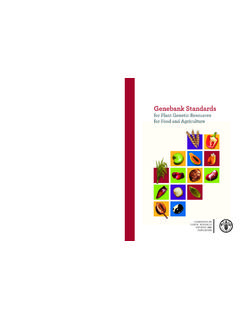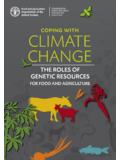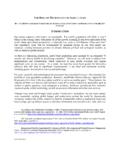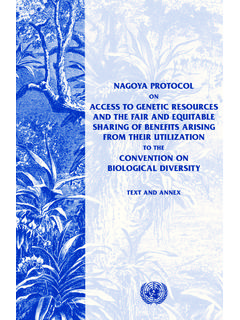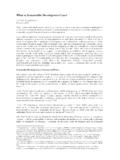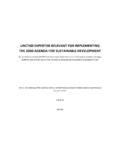Transcription of GCSE Science Combined Science and Biology Co …
1 Choose option 1of 21 Biology Co-teaching Combined Science and Biology April 2016 Area Spec reference Combined and Biology Biology Only Combined Biology Cell Biology Cell Structure Eukaryotes and prokaryotes Animal cells and plant cells Cell specialisation Cell differentiation Microscopy Culturing microorganisms Cell division Chromosomes Mitosis and the cell cycle Stem cells Transport in cells Diffusion Osmosis Active transport Organisation Principles of organisation Principals of organisation Animal tissue, organs and organ system The human digestive system The heart and blood vessels Blood Coronary heart disease.
2 A non-communicable disease Choose option 2of 21 Health issues The effect of lifestyle on some non-communicable diseases Cancer Plant tissue, organs and systems Plant tissues Plant organ system Infection and response Communicable diseases Communicable (infectious) disease Viral diseases Bacterial diseases Fungal diseases Protist diseases Human defence systems Vaccination Antibiotics and painkillers Discovery and development of drugs Monoclonal antibodies Producing monoclonal antibodies (HT) Uses of monoclonal antibodies (HT) Plant disease Detection and identification of plant diseases Plant defence responses Bioenergetics Photosynthesis Photosynthetic reaction Rate of Photosynthesis Choose option 3of 21 Uses of glucose from photosynthesis Respiration Aerobic and anaerobic respiration Response to exercise Metabolism Homeostasis and response Homeostasis Homeostasis The human nervous system Structure and function ( The human nervous system for Combined )
3 The brain The eye Control of body temperature Hormonal coordination in humans Human endocrine system Control of blood glucose concentration Maintaining water and nitrogen balance in the body Hormones in human reproduction Contraception The use of hormones to treat infertility (HTonly) Negative feedback (HTonly) Plant Hormones Control and coordination Use of plant hormones Choose option 4of 21 (HTonly) Inheritance , variation and evolution Reproduction Sexual and asexual reproduction Meiosis Advantages and disadvantages of sexual and asexual reproduction DNA and the genome DNA structure Genetic inheritance Inherited disorders Sex determination Variation and evolution Variation Evolution Selective breeding Genetic engineering Cloning The development of understanding of genetics and evolution Theory of evolution Speciation The understanding of genetics Evidence for evolution Fossils Extinction Resistant bacteria Classification of
4 Living organisms Classification of living organisms Choose option 5of 21 Ecology Adaptions , interdependence and competition Communities Abiotic factors Biotic factors Adaptations Organisation of an ecosystem Levels of organisation How materials are cycled Decomposition Impact of environmental change (HT only) Biodiversity and the effect of human interaction on ecosystems Biodiversity Waste management Land use Deforestation Global warming Maintaining biodiversity Trophic levels in an ecosystem Trophic levels Pyramids of biomass Transfer of biomass Food production Factors affecting food security Farming techniques Sustainable fisheries Role of biotechnology Choose option 6of 21 Biology only content Culturing microorganisms ( Biology only) Content Key opportunities for skills development Bacteria multiply by simple cell division (binary fission) as often as once every 20 minutes if they have enough nutrients and a suitable temperature.
5 Bacteria can be grown in a nutrient broth solution or as colonies on an agar gel plate. Uncontaminated cultures of microorganisms are required for investigating the action of disinfectants and antibiotics. MS 1a, 1b, 1d, 2a, 2h Calculate the number of bacteria in a population after a certain time if given the mean division time. MS 5c Calculate cross-sectional areas of colonies or clear areas around colonies using r . Students should be able to describe how to prepare an uncontaminated culture using aseptic technique. They should be able to explain why: Petri dishes and culture media must be sterilised before use inoculating loops used to transfer microorganisms to the media must be sterilised by passing them through a flame the lid of the Petri dish should be secured with adhesive tape and stored upside down in school and college laboratories, cultures should be incubated at a maximum temperature of 25 C. WS , Students should be able to calculate cross-sectional areas of colonies or clear areas around colonies using r.
6 MS 5c Students should be able to calculate the number of bacteria in a population after a certain time if given the mean division time. MS 1a, 2a, 2h (HT only) Students should be able to express the answer in standard form. MS 1b Required practical activity 2: investigate the effect of antiseptics or antibiotics on bacterial growth using agar plates and measuring zones of inhibition. AT skills covered by this practical activity: AT 1, 3, 4 and 8. This practical activity also provides opportunities to develop WS and MS. Details of all skills are given in Key opportunities for skills development (page 96). There are links with this practical to Antibiotics and painkillers (page 36). Choose option 7of 21 Monoclonal antibodies ( Biology only) (HT only) Producing monoclonal antibodies Content Key opportunities for skills development Students should be able to describe how monoclonal antibodies are produced. Monoclonal antibodies are produced from a single clone of cells.
7 The antibodies are specific to one binding site on one protein antigen and so are able to target a specific chemical or specific cells in the body. They are produced by stimulating mouse lymphocytes to make a particular antibody. The lymphocytes are Combined with a particular kind of tumour cell to make a cell called a hybridoma cell. The hybridoma cell can both divide and make the antibody. Single hybridoma cells are cloned to produce many identical cells that all produce the same antibody. A large amount of the antibody can be collected and purified. Uses of monoclonal antibodies Content Key opportunities for skills development Students should be able to describe some of the ways in which monoclonal antibodies can be used. Some examples include: For diagnosis such as in pregnancy tests. In laboratories to measure the levels of hormones and other chemicals in blood, or to detect pathogens. In research to locate or identify specific molecules in a cell or tissue by binding to them with a fluorescent dye.
8 To treat some diseases: for cancer the monoclonal antibody can be bound to a radioactive substance, a toxic drug or a chemical which stops cells growing and dividing. It delivers the substance to the cancer cells without harming other cells in the body. Students are not expected to recall any specific tests or treatments but given appropriate information they should be able to explain how they work. WS Appreciate the power of monoclonal antibodies and consider any ethical issues. Monoclonal antibodies create more side effects than expected. They are not yet as widely used as everyone hoped when they were first developed. WS Evaluate the advantages and disadvantages of monoclonal antibodies. Choose option 8of 21 Plant disease ( Biology only) Detection and identification of plant diseases Content Key opportunities for skills development (HT only) Plant diseases can be detected by: stunted growth spots on leaves areas of decay (rot) growths malformed stems or leaves discolouration the presence of pests.
9 (HT only) Identification can be made by: reference to a gardening manual or website taking infected plants to a laboratory to identify the pathogen using testing kits that contain monoclonal antibodies. WS The everyday application of scientific knowledge to detect and identify plant disease. Plants can be infected by a range of viral, bacterial and fungal pathogens as well as by insects. Knowledge of plant diseases is restricted to tobacco mosaic virus as a viral disease, black spot as a fungal disease and aphids as insects. Plants can be damaged by a range of ion deficiency conditions: stunted growth caused by nitrate deficiency chlorosis caused by magnesium deficiency. Knowledge of ions is limited to nitrate ions needed for protein synthesis and therefore growth, and magnesium ions needed to make chlorophyll. WS The understanding of ion deficiencies allows horticulturists to provide optimum conditions for plants. Plant defence responses Content Key opportunities for skills development Students should be able to describe physical and chemical plant defence responses.
10 Physical defence responses to resist invasion of microorganisms. Cellulose cell walls. Tough waxy cuticle on leaves. Layers of dead cells around stems (bark on trees) which fall off. Chemical plant defence responses. Antibacterial chemicals. Poisons to deter herbivores. There are links with this content to Adaptations (page 73). Choose option 9of 21 Mechanical adaptations. Thorns and hairs deter animals. Leaves which droop or curl when touched. Mimicry to trick animals. The brain ( Biology only) Content Key opportunities for skills development The brain controls complex behaviour. It is made of billions of interconnected neurones and has different regions that carry out different functions. Students should be able to identify the cerebral cortex, cerebellum and medulla on a diagram of the brain, and describe their functions. (HT only) Students should be able to explain some of the difficulties of investigating brain function and treating brain damage and disease.










